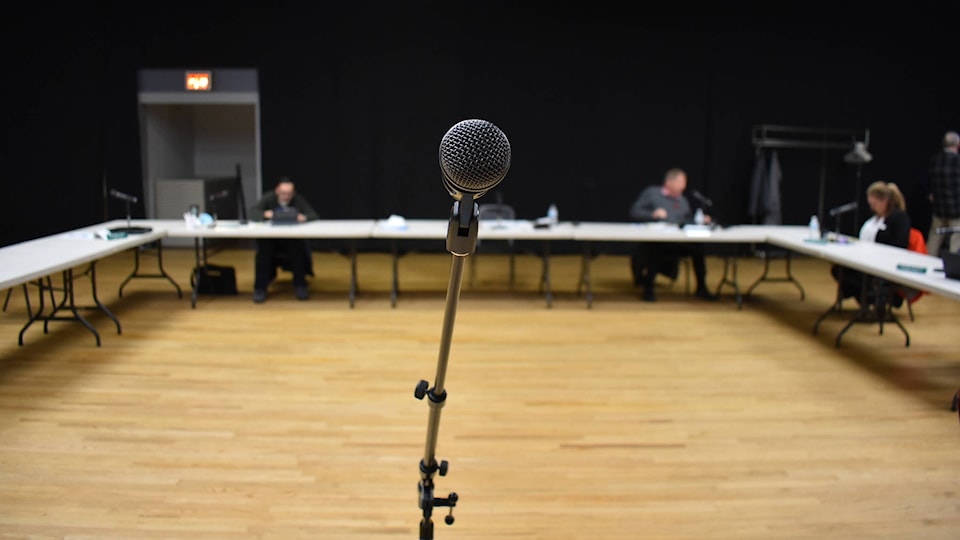Two days of public hearings into a proposed supportive housing development kicked off in Hope Tuesday, yet the turnout was lower than expected as Mayor and council were left waiting for walk-ins at the Legion hall.
Twelve people showed up to speak in support and against the proposed 52-unit supportive housing building at 650 Old Hope Princeton Way. Some also shared personal experience with housing, homelessness and addictions Monday afternoon. They had an attentive audience of Mayor Peter Robb and council members, save for councillor Dusty Smith who was not in attendance, as well as district administration, members of BC Housing and Fraser Health as well as members of the Hope and Area Transition Society.
Several residents expressed fears that the community’s services, whether they be police, fire, ambulance or hospital, were not sufficient to handle the needs of people in the proposed development. Others said that housing people would bring down the pressures on the medical system.
Business owners across from the proposed development spoke in strong opposition to the development. “Do we need to fence our entire property with razor wire? What is council going to do to support us? What are you going to do to keep us safe?” they wondered, adding that they had issues with people sleeping in their vehicles.
Two residents spoke of issues with break-ins at their residences, another spoke of incidents along Old Hope Princeton Way. A resident of Beacon Road said his home had been broken into six times. He asked whether there would be more police if the supportive housing build went ahead.
That wasn’t something he had yet discussed with Hope’s staff sergeant, Mayor Robb said. The building would have a system where nobody would be let in or out without being buzzed in said Brian Dodd, program coordinator at Hope’s emergency shelter. The shelter is run by the Hope and Area Transition Society, who would also be the operator of the planned supportive housing building.
Jeff Kuhn, speaking not as pastor for Grace Baptist Church but as a community member, asked council to “see beyond the rants on Facebook and look to the research instead of the reactions” when making their decision. He addressed what he saw as the two major reasons behind opposition to the development – the fact that it is low barrier, and the worry that it would bring people to the community from other parts of the Lower Mainland to live in the units.
“I deal face-to-face on a regular basis with many in our community who are homeless and struggling with addiction. Often the addiction is one way they cope with the suffering caused by having no fixed address,” he said. “Research on the housing first approach shows repeatedly that it’s more effective in helping people move out of addiction, than an approach which requires leaving addiction prior to housing being made available.”
Crystal Wiebe, speaking on behalf of Anhart Community Housing where she is a housing consultant, said the need exists in the community for this development. There were 220 applicants for Anhart’s 40-unit affordable housing complex in Hope when it opened, Wiebe said. One third of applicants were in shelters, hotels, living on the street or in a vehicle. Another third were in shared accomodations that were not permanent, and the last third were looking for better housing options.
One resident shared her own experience facing discrimination, in particular housing discrimination, as an urban Indigenous child and later as a single mother of three. She recalled applying for subsidized housing in Kamloops and then reading about neighbours’ resistance to these developments due to fear of crime and lower property values. “I keenly felt the discrimination of others, and longed for them to understand that sometimes our experiences were beyond our control,” she said. “It hurt to be stigmatized in such a way. Although I did not use alcohol or other substances, as a single parent I needed the support and understanding from my community.”
Residents also got involved through written submissions, which Mayor Robb read into the record Monday night.
These included 80 submissions in favour and 41 in opposition of the proposed development.
Hearings are set to continue Tuesday evening at 6 p.m. and Wednesday (Nov. 4) starting at 1 p.m. The hearings won’t be broadcast on the district’s Facebook page as previously stated, instead they are being recorded by the District of Hope Ratepayers Association and will be posted on Youtube after the hearings.
Pick up the November 12 edition of the Hope Standard to read a full account of the two days of hearings.
Do you have something to add to this story, or something else we should report on? Email:
emelie.peacock@hopestandard.com
